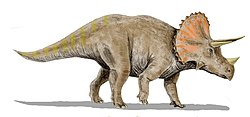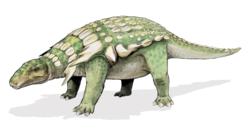Types of Dinosaur
WARNING: This is a WIP. Please edit to help to complete this page on WikiVersity.
Theropod Dinosaurs
[edit | edit source]




4 toed (but only 3 were used for walking), bipedal dinosaurs, and all birds, are theropod dinosaurs. Examples include Tyrannosaurus and Coelophysis rhodensis.
Coelophysoids
[edit | edit source]Coelophysoids are primitive, slender theropods with four fingers on each hand. They include Coelophysis and Dilophosaurus.
Abelisaurs and Ceratosaurs
[edit | edit source]Abelisauridae was a family of short armed predatory dinosaurs, such as Abelisaurus. The other group of abelisaurs, Noasauridae, had longer arms, but were smaller and more agile. Ceratosaurs, like Ceratosaurus, were large theropods with horns and their heads. Both of these groups had 4 fingers.
Megalosauroids
[edit | edit source]The megalosauroids are composed of two groups: Megalosauridae and Spinosauridae. The megalosaurs were typical big theropods, but the spinosaurs are unusual. They had vertebrae with long spines on them that form a sail on the back in life. They ate fish and spent most of their time in the water. This group includes Spinosaurus and Baryonyx.
Carnosaurs
[edit | edit source]The carnosaurs include famous dinosaurs like Allosaurus and Giganotosaurus. They had lightweight skulls, big hand claws, and three fingers.
Coelurosaurs
[edit | edit source]Coelurosaurian dinosaurs include Ornithomimus and Coelurus. This group was very diverse, but all of its members probably had some kind of fuzzy or feathery coat.
Tyrannosaurs
[edit | edit source]Tyrannosaurs had fused nasal bones in their skulls and long legs. The advanced species belong to a family called Tyrannosauridae, which includes Tyrannosaurus. They had short arms with only 2 fingers and large skulls.
Maniraptorans
[edit | edit source]Maniraptoran dinosaurs are one of the two existing dinosaur clades containing birds, the other is coelurosauria. Examples include Therizinosaurus and Deinonychus.
Sauropodomorph Dinosaurs
[edit | edit source]




Sauropodomorphs were mostly herbivorous, with some early taxa being omnivorous. These and theropods form the order Saurischia.
"Prosauropods"
[edit | edit source]This group of dinosaurs is not valid, as some "prosauropods" are more similar to sauropods than other "prosauropods". These early dinosaurs were mostly bipedal and omnivorous. Their hand had 5 fingers and 3 claws, one of which was very large. This grouping includes dinosaurs like Plateosaurus, Anchisaurus, and Massospondylus.
Sauropods
[edit | edit source]Sauropods are also called "long necked dinosaurs." They include some of the largest land animals ever.
Vulcanodonts
[edit | edit source]These are the most primitive sauropods. They include dinosaurs like Vulcanodon and Antetonitrus.
Cetiosaurs
[edit | edit source]Cetiosaurus means "whale lizard," because it was thought to be some kind of massive marine crocodile when it was discovered. Other dinosaurs in this group include Shunosaurus, which had a small tail club with spikes on it.
Mamenchisaurs
[edit | edit source]These dinosaurs had extremely long necks. They only lived in the Jurassic of Asia. Omeisaurus and Mamenchisaurus belong to this group.
Turiasaurs
[edit | edit source]While the mamenchisaurs lived in Asia, these sauropods lived in Europe. Some could grow to immense sizes, such as Turiasaurus
Rebbachisaurids
[edit | edit source]The most famous of these dinosaurs was Nigersaurus, nicknamed the dinosaur lawnmower. It had a broad snout with shearing teeth and ate low-lying plants. It did not have a whip-like tail.
Dicraeosaurids
[edit | edit source]These diplodocoids had very tall spines on their vertebrae, forming tall ridges on their backs. In Amargasaurus, these formed sharp spikes on the neck. Others, such as Dicraeosaurus, were less irregular. Brachytracheolopan has the shortest neck of any sauropod.
Diplodocids
[edit | edit source]This group of sauropods had very long necks and extremely long tails. Diplodocids are split into two groups: diplodocines, the longer, lighter ones like Diplodocus and Barosaurus, and the apatosaurines, the shorter, heavier ones like Apatosaurus and Brontosaurus.
Macronarians
[edit | edit source]Macronaria means "big nose," referring to the large nares of these sauropods.
Camarasaurs
[edit | edit source]These sauropods had short necks (for sauropods) and big, boxy heads. Examples include Camarasaurus.
Brachiosaurs
[edit | edit source]Brachiosaurs are derived dinosaurs, with a name meaning arm lizard, referencing the fact that their forelimbs were much taller than their hindlimbs. Brachiosaurus, Giraffatitan (which, confusingly, is what most Brachiosaurus images actually are), and Sauroposeidon, the tallest dinosaur.
Titanosaurs
[edit | edit source]Titanosaurs were the last surviving sauropods, dying out at the end of the Cretaceous. They include Argentinosaurus and Isisaurus. Most, if not all, had some form of armour. Argentinosaurus may have been the largest dinosaur ever.
Ornithischians
[edit | edit source]Ornithischians are named due to hips superficially resembling modern bird hipped dinosaurs, hence the name bird hipped dinosaurs. Most, if not all, members of this group were herbivorous.
Ceratopsia
[edit | edit source]
The group that includes the large and horned Triceratops and the small agile Psittacosaurus and evolved around '155 million years ago, in the Jurassic.
Iguanodontids
[edit | edit source]
Iguanodont dinosaurs included Iguanodon.
Ornithopods
[edit | edit source]They were in a specialised group called Ankypollexia. Genera as such include Parasaurolophus in Hadrosaurini and Hypsilophodon in Neoankypollexia.
Thyreophora
[edit | edit source]The name Thyreophora means shield bearer and this group includes armored dinosaurs such as the Stegosaurus and ankylosaurus.They were herbivores that lived from the early jurassic period to the the late cretaceous.
Ankylosauria
[edit | edit source]
Ankylosauria includes Ankylosaurus and Sauropelta.
